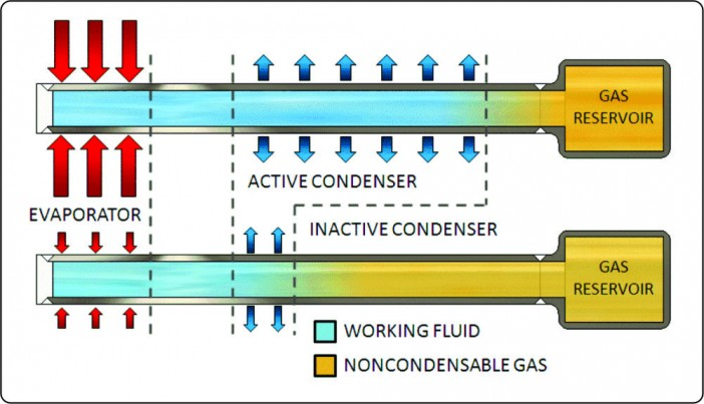A heat pipe is a two-phase device that has excellent heat transfer capabilities. It can transfer heat over long distances with minimum temperature drops and no need for external power. In our laboratory, we are investigating a special type of heat pipe which is the variable conductance heat pipe (VCHP). Unique to space missions is an important need to operate in both cold and hot environments during the missions. This is where VCHP can play an important role. In a VCHP, in addition to the working fluid, a non-condensable gas (NCG) is included inside the closed loop. The advantage is that the NCG allows VCHP to respond passively to changes in thermal environment.
Our research involves developing efficient configurations in VCHP using computational fluid dynamics modeling and experimental validation testing. We are currently collaborating with Advanced Cooling Technologies, LLC. in designing novel concepts in VCHP for future lunar and Mars missions.
Related Publications
[4] CN Huang, KL Lee, C Tarau, Y Kamotani, C Kharangate, Thermal and Hydrodynamic Analysis of a Self-Purging Hot Reservoir Variable Conductance Heat Pipe, Applied Thermal Engineering, 120346, https://doi.org/10.1016/j.applthermaleng.2023.120346
[3] K.-L. Lee, C. Tarau, W. Anderson, C.-N. Huang, C. Kharangate, Y. Kamotani, Integrated Hot Reservoir Variable Conductance Heat Pipes with Improved Reliability, (2022). https://www.1-act.com/wp-content/uploads/2022/07/ICES-2022-132-HotReservoirVCHPLoop_FInal.pdf
[2] KL Lee, C Tarau, A Lutz, WG Anderson, CN Huang, C Kharangate, Y Kamotani, Advanced Hot Reservoir Variable Conductance Heat Pipes for Planetary Landers. https://ttu-
[1] CN Huang, KL Lee, C Tarau, Y Kamotani, C Kharangate, Computational Fluid Dynamics Model for A Variable Conductance Thermosyphon, https://www.sciencedirect.com/science/article/pii/S2214157X21001234 ir.tdl.org/bitstream/handle/2346/86409/ICES-2020-579.pdf?sequence=3


